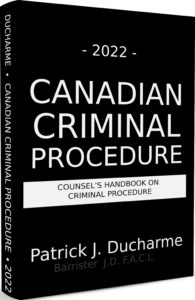 |
| Patrick Ducharme |
A warrant may be issued authorizing the installation of a tracking device.1 The tracking device may be placed in or on anything, including a thing carried, used or worn by any person. The warrant is issued where the Justice is satisfied that information that is relevant to an offence under investigation can be obtained through the use of the tracking device.
Subsection 24(2) of the Charter
This subsection provides that a court shall exclude evidence if the evidence was obtained in a manner that infringed or denied any rights or freedoms guaranteed by the Charter, having regard to all the circumstances, if the admission of it in the proceedings would bring the administration of justice into disrepute. Challenges to searches, whether by warrant or warrantless, utilize section 8 and subsection 24(2) of the Charter.
Subsection 24(2) must now be considered in light of the Supreme Court of Canada’s decisions in Harrison and Grant. Most Charter challenges are made pursuant to this subsection. In fact, if the remedy sought by the application is to quash a search warrant, or, is to exclude evidence, most Judges who receive such an application prior to trial will decline to entertain the application to quash a warrant or to make an order excluding evidence prior to trial, preferring an application at trial before the trial Judge. The rationale is that generally the trial Judge is usually in a better position to decide the application with the benefit of all the evidence at trial.
Continued in Part 2.

The above is the an excerpt of Patrick J Ducharme’s book, Canadian Criminal Procedure, available at Amazon or in bulk through MedicaLegal Publishing along with Criminal Trial Strategies.
Subscribe to Patrick Ducharme’s Youtube Channel
